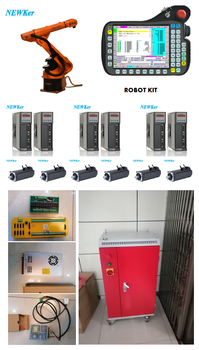Industrial robots are widely used in industrial manufacturing, such as automobile manufacturing, electrical appliances, and food. They can replace repetitive machine-style manipulation work and are a kind of machine that relies on its own power and control capabilities to achieve various functions. It can accept human command and can also operate according to pre-arranged programs. Now let’s talk about the basic components of industrial robots.
1. Main body
The main body is the machine base and the actuator, including the upper arm, lower arm, wrist and hand, forming a multi-degree-of-freedom mechanical system. Some robots also have walking mechanisms. Industrial robots have 6 degrees of freedom or more, and the wrist generally has 1 to 3 degrees of freedom.
2. Drive system
The drive system of industrial robots is divided into three categories according to the power source: hydraulic, pneumatic and electric. According to the needs, these three types of drive systems can also be combined and compounded. Or it can be indirectly driven by mechanical transmission mechanisms such as synchronous belts, gear trains, and gears. The drive system has a power device and a transmission mechanism to make the actuator produce corresponding actions. These three basic drive systems have their own characteristics. The mainstream is the electric drive system.
Due to the widespread acceptance of low inertia, high torque AC and DC servo motors and their supporting servo drivers (AC inverters, DC pulse width modulators). This type of system does not require energy conversion, is easy to use, and is sensitive to control. Most motors need to be installed with a precision transmission mechanism behind them: a reducer. Its teeth use the speed converter of the gear to reduce the number of reverse rotations of the motor to the desired number of reverse rotations, and obtain a larger torque device, thereby reducing the speed and increasing the torque. When the load is large, it is not cost-effective to blindly increase the power of the servo motor. The output torque can be improved by the reducer within the appropriate speed range. The servo motor is prone to heat and low-frequency vibration under low-frequency operation. Long-term and repetitive work is not conducive to ensuring its accurate and reliable operation. The existence of a precision reduction motor enables the servo motor to operate at an appropriate speed, strengthen the rigidity of the machine body, and output greater torque. There are two mainstream reducers now: harmonic reducer and RV reducer
The robot control system is the brain of the robot and the main factor that determines the function and performance of the robot. The control system sends command signals to the drive system and the actuator according to the input program and controls it. The main task of industrial robot control technology is to control the range of activities, postures and trajectories, and time of actions of industrial robots in the workspace. It has the characteristics of simple programming, software menu operation, friendly human-computer interaction interface, online operation prompts and convenient use.
The controller system is the core of the robot, and foreign companies are closely closed to Chinese experiments. In recent years, with the development of microelectronics technology, the performance of microprocessors has become higher and higher, while the price has become cheaper and cheaper. Now there are 32-bit microprocessors of 1-2 US dollars on the market. Cost-effective microprocessors have brought new development opportunities for robot controllers, making it possible to develop low-cost, high-performance robot controllers. In order to make the system have sufficient computing and storage capabilities, robot controllers are now mostly composed of strong ARM series, DSP series, POWERPC series, Intel series and other chips.
Since the existing general-purpose chip functions and features cannot fully meet the requirements of some robot systems in terms of price, function, integration and interface, the robot system has a need for SoC (System on Chip) technology. Integrating a specific processor with the required interface can simplify the design of the system’s peripheral circuits, reduce the system size, and reduce costs. For example, Actel integrates the processor core of NEOS or ARM7 on its FPGA products to form a complete SoC system. In terms of robot technology controllers, its research is mainly concentrated in the United States and Japan, and there are mature products, such as DELTATAU in the United States and TOMORI Co., Ltd. in Japan. Its motion controller is based on DSP technology and adopts an open PC-based structure.
4. End effector
The end effector is a component connected to the last joint of the manipulator. It is generally used to grasp objects, connect with other mechanisms and perform required tasks. Robot manufacturers generally do not design or sell end effectors. In most cases, they only provide a simple gripper. Usually the end effector is installed on the flange of the robot’s 6 axes to complete tasks in a given environment, such as welding, painting, gluing, and parts loading and unloading, which are tasks that require robots to complete.
Post time: Aug-18-2024









